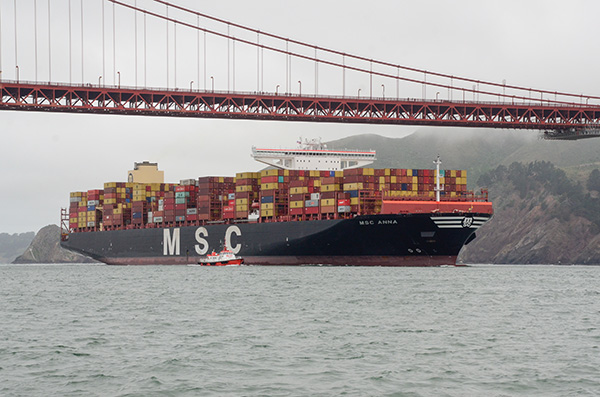Port Tracker report points to anticipated ongoing import growth in 2021

High levels of United States-bound retail container imports remain fully intact, amid the ongoing myriad challenges the ocean cargo market has faced over the course of the COVID-19 pandemic, according to the most recent edition of the Port Tracker report, which was issued by the National Retail Federation (NRF) and maritime consultancy Hackett Associates today.
The ports surveyed in the report include: Los Angeles/Long Beach; Oakland; Tacoma; Seattle; Houston; New York/New Jersey; Hampton Roads; Charleston, and Savannah; Miami; Jacksonville; and Fort Lauderdale, Fla.-based Port Everglades.
Authors of the report explained that cargo import numbers do not correlate directly with retail sales or employment because they count only the number of cargo containers brought into the country, not the value of the merchandise inside them, adding that the amount of merchandise imported provides a rough barometer of retailers’ expectations.
Coming on the heels of record 2020 import levels, the report explained that more monthly records are expected heading into the summer months, as the economy recovers from the pandemic.
“The import numbers we’re seeing reflect retailers’ expectations for consumer demand to the point that many factories in Asia that normally close for Chinese New Year this month are remaining open to keep up,” NRF Vice President for Supply Chain and Customs Policy Jonathan Gold said in a statement. “Regardless of whether it’s in-store or on retailers’ websites, the record holiday season and numbers for 2020 show consumers are buying again and have been for a while. This surge has been going on for months, and retailers are importing merchandise faster than ever.”
Port Tracker reported for December, the most recent month for which data is available, U.S-based retail container ports handled 2.11 million Twenty-Foot Equivalents (TEU), was eked out a 0.2% gain over November and a 22.3% annual increase. For all of 2020, the report stated that total imports—at 22 million TEU—saw a 1.9% annual gain over the 21.6 million TEU recorded for 2019, setting a new annual record, topping 2018’s 1.89 million TEU.
January imports, which are not yet available, are pegged to be up 14.6% annually, to 2.08 million TEU, which would mark the highest-volume January going back to when NRF initially tracked import data in 2002.
The report’s forecast for February, which is typically the slowest import month of the year, is atypical, with the report pegging imports, for the month, to be up 26.3% annually, to 1.91 million TEU. The report’s authors explained that while there is typically a lull between the holiday season and the spring months, due to Asian factories closing for the Chinese New Year, this year is different in that there have been 25-30 vessels waiting to dock at the Ports of Los Angeles and Long Beach, due to congestion at terminals related to reported equipment and labor shortages, as many factories in Asia are staying open in order to meet demand.
Looking past February, the report said that March is expected to climb 41% annually, to 1.93 million TEU, with the major annal gain attributed to easier annual comparisons, with Chinese factories having shuttered in March 2020, due to the pandemic. April and May are expected to be up 13.3%, to 1.82 million TEU, and 23.8%, to 1.9 million TEU, respectively. June is estimated to be up 18.2%, to 1.9 million TEU.
Should each month, from January to June, meet its projected import volumes, a new record would be set for each month, according to the report. And the first half of 2021 is pegged to increase 22.1%, to 11.5 million TEU.
“As we continue to struggle with COVID-19 and the ups and down in the economy, year-over-year increases in the flow of containerized goods have become dramatic, and even more so because of the comparison of unusually strong periods against unusually weak periods,” wrote Hackett Associates Founder Ben Hackett in the report. “It is impressive that the cargo volumes handled by the ports remain as high as they are despite congestion at the docks and the spread of the coronavirus among workers throughout the supply chain.”
Hackett added that even with retail sales doing well in most sectors, he said he can only surmise that the dramatic growth in imports has gone at least partly into inventory.
“Importers have clearly remained optimistic despite the industrial slowdown and appear hopeful that the rollout of COVID-19 vaccines will trigger a rebound in the economy and added growth in consumer spending,” he wrote. “The strongest sector of retail consumption has been online sales, which require a larger level of inventory as consumers expect next day, if not same-day, delivery.”

Article Topics
Latest in Logistics
Shipment and expenditure decreases trend down, notes Cass Freight Index March trucking tonnage trends down, reports ATA FTR Shippers Conditions Index enters negative territory DAT March Truckload Volume Index sees modest March gains National diesel average, for week of April 22, is down for the second straight week UPS reports first quarter earnings decline LM Podcast Series: Assessing the freight transportation and logistics markets with Tom Nightingale, AFS Logistics More LogisticsAbout the Author
Subscribe to Logistics Management Magazine

Find out what the world's most innovative companies are doing to improve productivity in their plants and distribution centers.
Start your FREE subscription today.
April 2023 Logistics Management

Latest Resources














